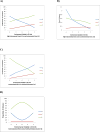Biometric Modeling of Gene-Environment Interplay: The Intersection of Theory and Method and Applications for Social Inequality
- PMID: 26426103
- PMCID: PMC4818206
- DOI: 10.1111/jopy.12231
Biometric Modeling of Gene-Environment Interplay: The Intersection of Theory and Method and Applications for Social Inequality
Abstract
For more than a decade, biometric moderation models have been used to examine whether genetic and environmental influences on individual differences might vary within the population. These quantitative Gene × Environment interaction models have the potential to elucidate not only when genetic and environmental influences on a phenotype might differ, but also why, as they provide an empirical test of several theoretical paradigms that serve as useful heuristics to explain etiology-diathesis-stress, bioecological, differential susceptibility, and social control. In the current article, we review how these developmental theories align with different patterns of findings from statistical models of gene-environment interplay. We then describe the extant empirical evidence, using work by our own research group and others, to lay out genetically informative plausible accounts of how phenotypes related to social inequality-physical health and cognition-might relate to these theoretical models.
© 2015 Wiley Periodicals, Inc.
Conflict of interest statement
Susan C. South, Department of Psychological Sciences, Purdue University; Nayla R. Hamdi, Department of Psychology, University of Minnesota; Robert F. Krueger, Department of Psychology, University of Minnesota. The authors declared no potential conflicts of interest with respect to the research, authorship, and/or publication of this article.
Figures


References
-
- Bates TC, Lewis GJ, Weiss A. Childhood socioeconomic status amplifies genetic effects on adult intelligence. Psychological Science. 2013;24:2111–2116. - PubMed
-
- Belsky J, Pluess M. Beyond diathesis stress: Differential susceptibility to environmental influences. Psychological Bulletin. 2009;135:885–908. - PubMed
-
- Benjamin DJ, Cesarini D, van der Loos MJHM, Dawes CT, Koellinger PD, Magnusson PKE, et al. Visscher PM. The genetic architecture of economic and political preferences. Proceedings of the National Academy of Sciences of the United States of America. 2012;109(21):8026–8031. doi: 10.1073/pnas.1120666109. - DOI - PMC - PubMed
-
- Bronfenbrenner U, Ceci SJ. Nature-nurture reconceptualized in developmental perspective: A bioecological model. Psychological Review. 1994;101:568–586. - PubMed
Publication types
MeSH terms
Grants and funding
LinkOut - more resources
Full Text Sources
Other Literature Sources

